5 things to know about the 2021 Toyota Mirai
At a recent press event at Toyota Motors North America’s headquarters in Plano, Texas, the most popular vehicle to test drive was not the gorgeous six-figure Lexus LC500 sports coupe, nor was it the Toyota Land Cruiser leaving American shores. Instead media members lined up to test the redesigned 2021 Toyota Mirai hydrogen-powered sedan.
One reason for the interest deep in the heart of Texas was because the forward-looking five-seater is sold in limited numbers only in California and, like most consumers, few of us have been able to test drive.
The most compelling reason for the interest, however, was because the Mirai emits only water vapor in an increasingly hot, arid world undergoing climate change—and could, with the right infrastructure in place, help cut greenhouse-gas emissions. It’s a shame there’s not much infrastructure or incentives to support it.

2021 Toyota Mirai
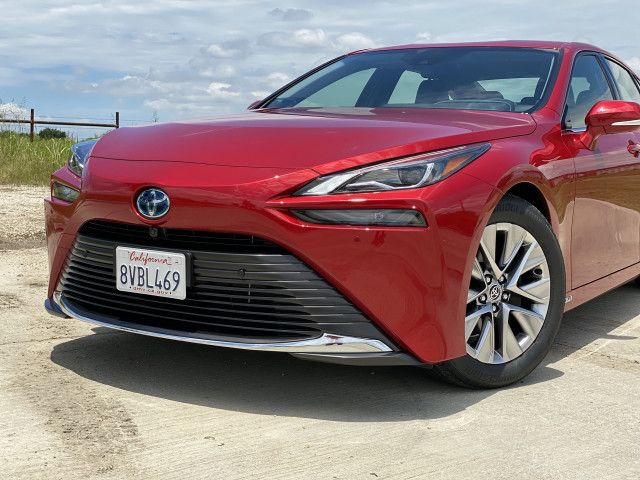
2021 Toyota Mirai
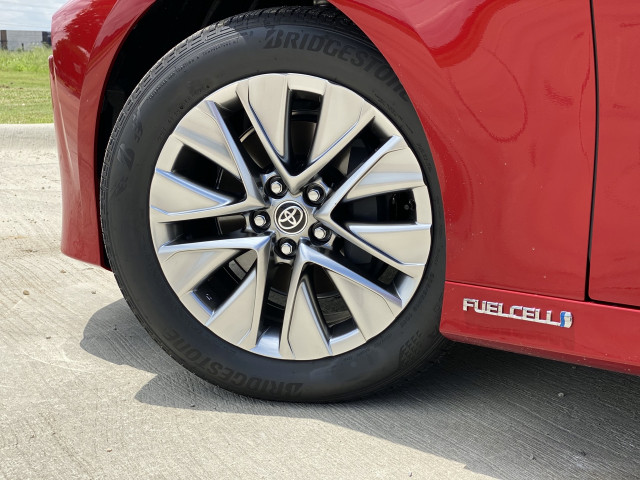
2021 Toyota Mirai
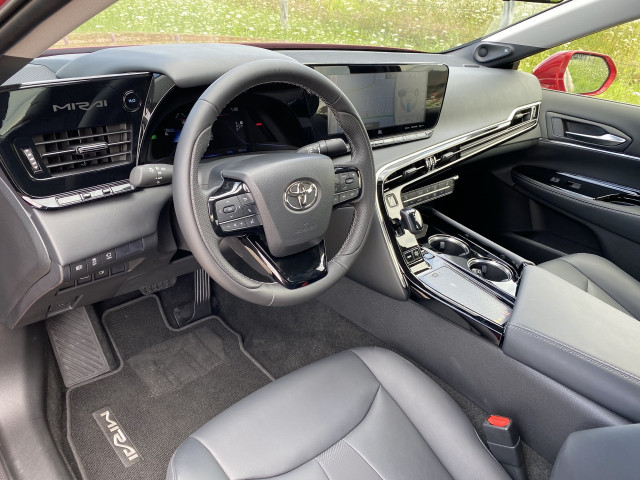
2021 Toyota Mirai
1. Luxury-like style
With its long hood and short decklid, the second-generation Mirai looks more like a German grand tourer befitting its ride quality. Its predecessor appeared more like a Prius graduated from art school, and lacked the stateliness the Mirai deserves. Longer, lower, and wider, it looks much more like a Lexus than a Toyota, inside and out, which makes sense since it shares the rear-drive platform of the flagship Lexus LS sedan. It attracts eyeballs, even before they notice the fuel cell badges.
2. 402-mile range
The 2021 Mirai comes in two trims with two range estimates, both big improvements over the smaller outgoing model’s 312-mile range. The base XLE has a 402-mile range on 19-inch wheels, while the heavier Limited and its 20-inch wheels has a 357-mile range. It lacks the off-the-line surge of battery electric vehicles, but has plenty of punch for passing moves. Its low center of gravity and even weight distribution between the axles help keep the 4,300-pound Mirai planted and more fun to drive than most crossovers, and it moves with more elan than the Toyota Avalon or other full-size sedans.

2021 Toyota Mirai
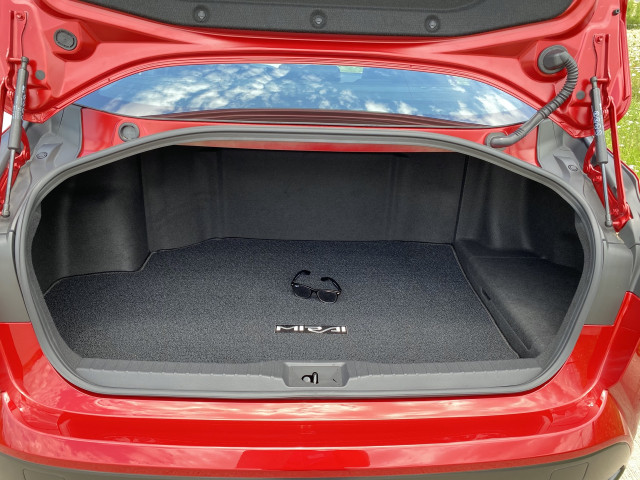
2021 Toyota Mirai
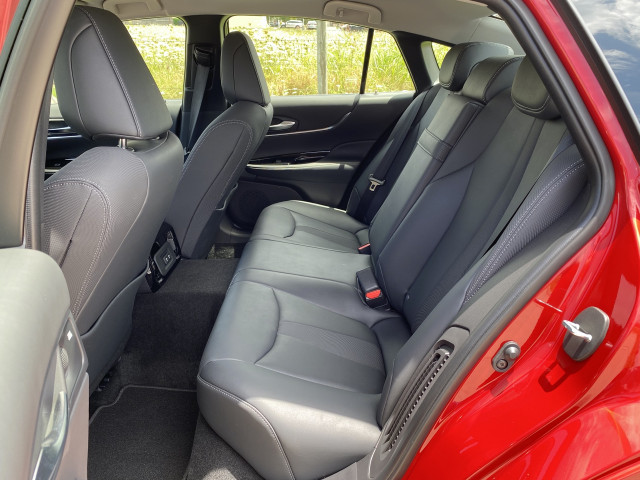
2021 Toyota Mirai
3. Interior limitations
Though it shares the proportions of the Lexus LS 500 full-size sedan, the rear seat and trunk space come up short due to the placement of the three hydrogen tanks. One of them is in front-to-rear tunnel running under the fifth seat, so it’s more cramped than similar seats in other full-size sedans. The trunk carries 9.6 cubic feet of cargo, down from 15.2 cubes in the LS hybrid sedan or 16.9 cubes in the gas-only 2021 LS sedan.
4. Water purge

2021 Toyota Mirai – Portland OR
If you were to overlook the badging and the limited space in the rear seats and trunk, it would be hard to distinguish the Mirai from other electric vehicles. The standard 12.3-inch touchscreen shows the familiar Toyota energy cycle display, but with a gimmicky air purifying meter suggesting that the air coming out of the car is cleaner than the air coming in—so allegedly the more you drive, the more air you clean. The water purge button on the left of the instrument cluster is more scientifically accurate.
The Mirai is powered by an electric motor and uses a lithium-ion battery for power off the line, and to fill the gaps while the fuel-cell stack (smaller, lighter, and more efficient than in the outgoing model) ramps up its own power delivery. It’s all seamless to the driver. The Mirai sucks in oxygen from the air that is mixed with hydrogen from the fuel tank. A chemical reaction between the two creates electricity that powers the car. The byproduct of that reaction is water.
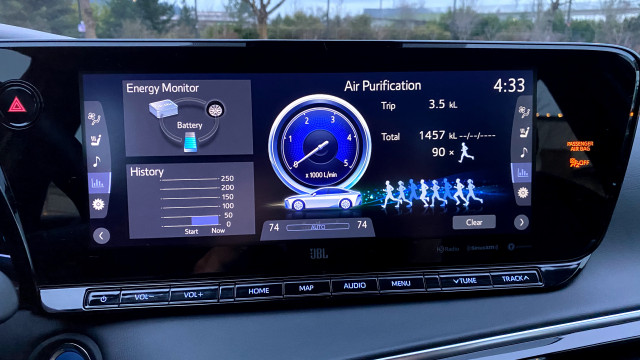
Air purification displays – 2021 Toyota Mirai

2021 Toyota Mirai – Portland OR

Air purification displays – 2021 Toyota Mirai
The system automatically discharges water through a “tailpipe” beneath the hydrogen tanks in front of the rear axle. Pushing the button to the left of the cluster also empties any accumulated water, and is recommended before drivers pull into their garage so there isn’t a small puddle of water the next time they drive the car. It’s not potable; during a test drive our intrepid reporter, Brian Wong, was told by Toyota PR not to drink it.

2021 Toyota Mirai
5. Infrastructure limitations
The Mirai is one of only three hydrogen fuel cell passenger vehicles being sold. The 2021 Hyundai Nexo has a 380-mile range, the 2021 Honda Clarity fuel cell has a 360-mile range, both can only be leased, and the available dealers are a fraction of Toyota’s certified FCEV network. Toyota has the lead with FCEVs, but the advantage for a business case is unclear.
The second-generation Mirai went on sale early this year with $9,050 cut off the sticker price of the previous generation to start at $50,495, including destination, for the base XLE. The Limited model costs $66,955. Toyota includes $15,000 in hydrogen fueling credits with three-year leases, and the same amount for owners to spend over six years. The federal government adds an $8,000 hydrogen fuel cell tax credit and the state of California will trim $4,500 off your tax bill if you owe. The incentives are there because the infrastructure isn’t. There are 51 hydrogen fueling stations in southern California and in the San Francisco-Sacramento area, with nearly another 50 more awaiting permitting or completed construction, according to a map maintained by the California Fuel Cell Partnership.

2021 Toyota Mirai – Portland OR
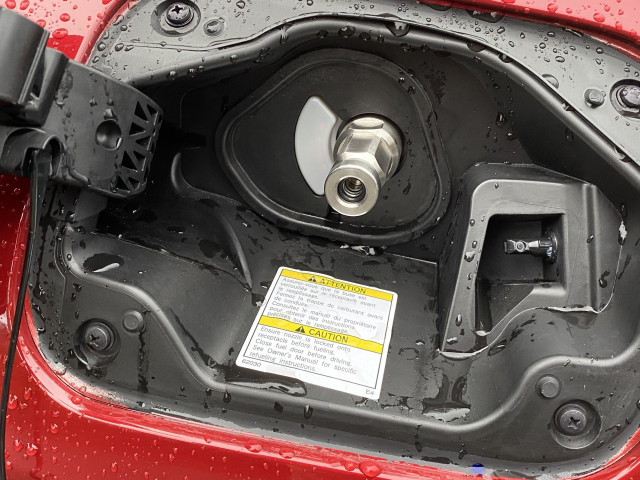
2021 Toyota Mirai – Portland OR
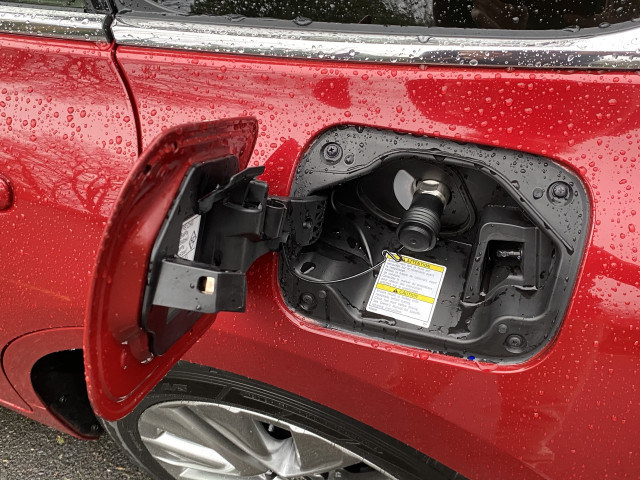
2021 Toyota Mirai – Portland OR
In partnerships with hydrogen fueling companies such as Iwatani, Toyota plans more stations. That includes incremental rollouts in other zero-emission states in the northwest and other coastal regions. But you can’t charge at home, or few other places, so interest in Mirai remains limited. Toyota had to truck the cars from California to Texas for the media drives, and hope the full tanks of hydrogen wouldn’t be used before the conclusion of the demonstration. There are few things less efficient than trucking cars halfway across the country.
But the potential is there, as Toyota has demonstrated with the Mirai. Too bad potential doesn’t sell cars.

